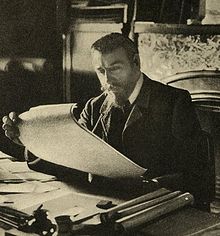Maison du Peuple, Brussels

The Maison du Peuple (French) or Volkshuis (Dutch), both literally translated as "House of the People", was a public building in Brussels which was one of the largest works by Belgian architect Victor Horta. The building was one of the most important buildings in the Art Nouveau style in Belgium and opened on 2 April 1899. It was commissioned by the Belgian Workers' Party (POB-BWP).
Its demolition in 1965, and replacement by a skyscraper, is regarded as one of the foremost examples of "Brusselization".
Building
In spite of a rather restrictive very irregular building place along a circular square and on a slope, Horta succeeded to construct a building with maximum functionality. The building provided rooms for several aims like offices, coffee shops, shops, meeting rooms and a party hall. The building had been mainly constructed in white iron (more than 600,000 kilogrammes). Fifteen craftsmen worked for eighteen months on the iron work. To make this construction possible, Horta drew no less than 8,500 square meters of plans. The building was completed in 1899 and was considered a master work. Because of the experimental combination of brick, glass and steel this building was considered as an example of modern architecture.
It was situated on Place Emile Vandervelde, near to the Sablon.
Demolition
In spite of an international protest movement of over 700 architects, the building was demolished in 1965. The building was dismantled entirely with the idea of rebuilding it elsewhere. However, the components of the building were scattered in vacant lots around Brussels, and the building was never reconstructed. Later, structural parts of the building were used in the Horta Grand Café in Antwerp.
The loss of the Maison du Peuple was part of the trend of Brusselization, where many historic buildings were wantonly replaced by unsightly skyscrapers. The Maison du Peuple itself was replaced by a generic building, built the year immediately after the Maison du Peuple's demolition.
